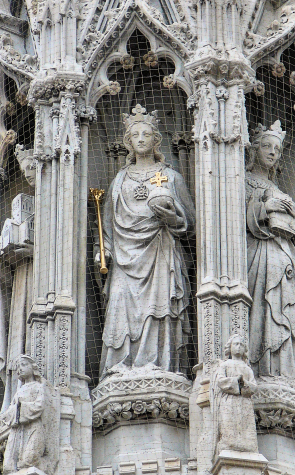Eleanor Cross
The Eleanor Cross at Charing Cross
 The medieval village of Charing probably took its name from the Old English cerring, ‘a turn’, referring either to the bend in the Thames or in the westward road from the City.
The medieval village of Charing probably took its name from the Old English cerring, ‘a turn’, referring either to the bend in the Thames or in the westward road from the City.
According to legend, Eleanor of Castile, queen consort of Edward I, sank here and rose again at Queenhithe. The story seems to have begun with an anonymously written ballad that suggests, among much anti-Spanish derision, that Eleanor murdered the lord mayor of London’s wife by thrusting venomous snakes into her bosom. When Edward accused his queen of the deed she denied it and wished the ground might swallow her up if she lied:
With that, at Charing Cross she sunk
Into the ground alive;
And after rose with life again,
In London, at Queenhithe.
Thereafter she languished 20 days in pain, and confessed to the crime and also to bearing a child by a friar. The poet’s choice of location for the sinking is curious (but presumably deliberate) as Charing wouldn’t have become Charing Cross had it not been for the king’s grief at his wife’s death at the age of 49.
Eleanor died at Harby in Nottinghamshire in 1290 and was buried in Westminster Abbey. Crosses were set up at each of the 12 places where her body rested on its journey southwards, of which three survive: at Geddington and Hardingstone (both in Northamptonshire) and Waltham (now Waltham Cross, Hertfordshire).
The cross at Charing, which stood just to the south of what is now Trafalgar Square, was demolished in 1647 and much of its stone was used to pave Whitehall. An equestrian statue of Charles I was erected in its place in 1675 and now marks the exact point from which all distances from London are measured.
The present Gothic cross in the courtyard of Charing Cross station (detail shown above) was designed by Edward Middleton Barry, sculpted by Thomas Earp and erected in 1865.

